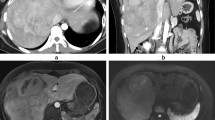Abstract
We report a male case of beta-catenin-activated hepatocellular adenoma (HCA) focusing on findings of gadoxetic-acid-enhanced magnetic resonance imaging (EOB-MRI) and discussing the molecular background and possible clinical significance. The patient was a 31-year-old man in whom computed tomography (CT) showed a large nodule of 14 cm in diameter in the right liver lobe. On dynamic contrast-enhanced CT, heterogeneous and slight to moderate enhancement was observed during the early phase, with washout in the late phase. Focal fat deposits and a scar-like portion in the lesion were also seen. Most of the lesion was slightly hyperintense compared with the background liver on the hepatobiliary phase of EOB-MRI. After operation, this patient was confirmed pathologically as having beta-catenin-activated HCA with a portion suggestive of malignant transformation. In addition, intense organic anion transporter polypeptide 8 expression was observed throughout the tumor by immunohistochemical staining.




Similar content being viewed by others
References
Zucman-Rossi J, Jeannot E, Nhieu JT, Scoazec JY, Guettier C, Rebouissou S, et al. Genotype–phenotype correlation in hepatocellular adenoma: new classification and relationship with HCC. Hepatology. 2006;43(3):515–24.
Bioulac-Sage P, Laumonier H, Couchy G, Le Bail B, Sa Cunha A, Rullier A, et al. Hepatocellular adenoma management and phenotypic classification: the Bordeaux experience. Hepatology. 2009;50(2):481–9.
van Aalten SM, Thomeer MG, Terkivatan T, Dwarkasing RS, Verheij J, de Man RA, et al. Hepatocellular adenomas: correlation of MR imaging findings with pathologic subtype classification. Radiology. 2011;261(1):172–81.
Purysko AS, Remer EM, Coppa CP, Obuchowski NA, Schneider E, Veniero JC. Characteristics and distinguishing features of hepatocellular adenoma and focal nodular hyperplasia on gadoxetate disodium-enhanced MRI. Am J Roentgenol. 2012;198(1):115–23.
Kitao A, Zen Y, Matsui O, Gabata T, Kobayashi S, Koda W, Kozaka K, et al. Hepatocellular carcinoma: signal intensity at gadoxetic acid-enhanced MR imaging—correlation with molecular transporters and histopathologic features. Radiology. 2010;256(3):817–26.
Sekine S, Ogawa R, Ojima H, Kanai Y. Expression of SLCO1B3 is associated with intratumoral cholestasis and CTNNB1 mutations in hepatocellular carcinoma. Cancer Sci. 2011;102(9):1742–7.
Lim AK, Patel N, Gedroyc WM, Blomley MJ, Hamilton G, Taylor-Robinson SD. Hepatocellular adenoma: diagnostic difficulties and novel imaging techniques. Br J Radiol. 2002;75(896):695–9.
Ichikawa T, Federle MP, Grazioli L, Nalesnik M. Hepatocellular adenoma: multiphasic CT and histopathologic findings in 25 patients. Radiology. 2000;214(3):861–8.
Huppertz A, Haraida S, Kraus A, Zech C, Scheidler J, Breuer J, et al. Enhancement of focal liver lesions at gadoxetic acid-enhanced MR imaging: correlation with histopathologic findings and spiral CT—initial observations. Radiology. 2005;234(2):468–78.
Vander Borght S, Libbrecht L, Blokzijl H, Faber KN, Moshage H, Aerts R, et al. Diagnostic and pathogenetic implications of the expression of hepatic transporters in focal lesions occurring in normal liver. J Pathol. 2005;207(4):471–82.
Author information
Authors and Affiliations
Corresponding author
About this article
Cite this article
Yoneda, N., Matsui, O., Kitao, A. et al. Beta-catenin-activated hepatocellular adenoma showing hyperintensity on hepatobiliary-phase gadoxetic-enhanced magnetic resonance imaging and overexpression of OATP8. Jpn J Radiol 30, 777–782 (2012). https://doi.org/10.1007/s11604-012-0115-2
Received:
Accepted:
Published:
Issue Date:
DOI: https://doi.org/10.1007/s11604-012-0115-2




